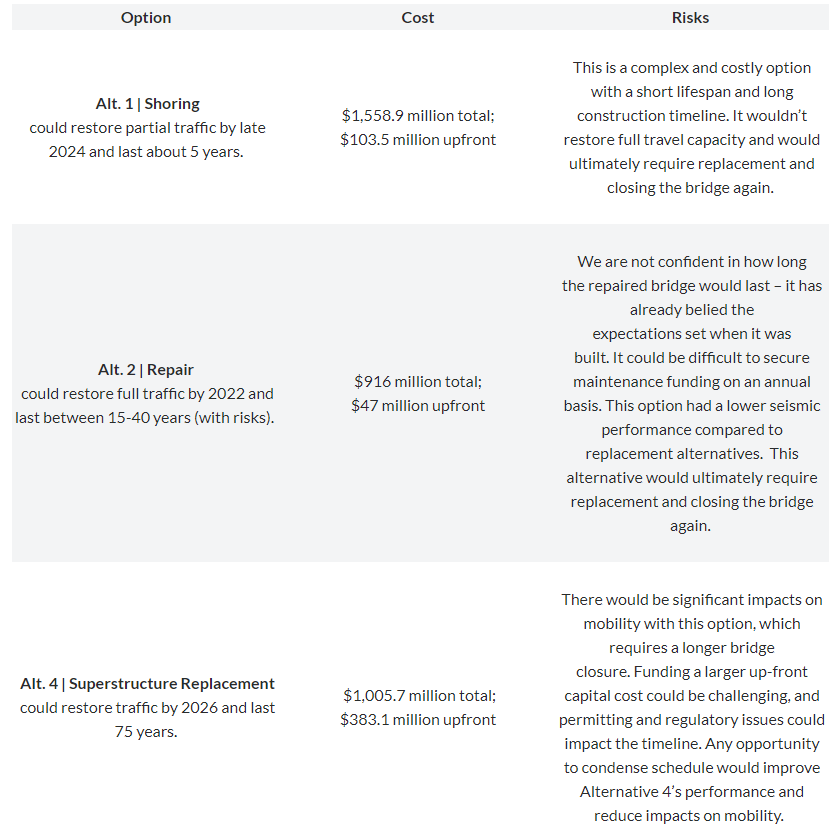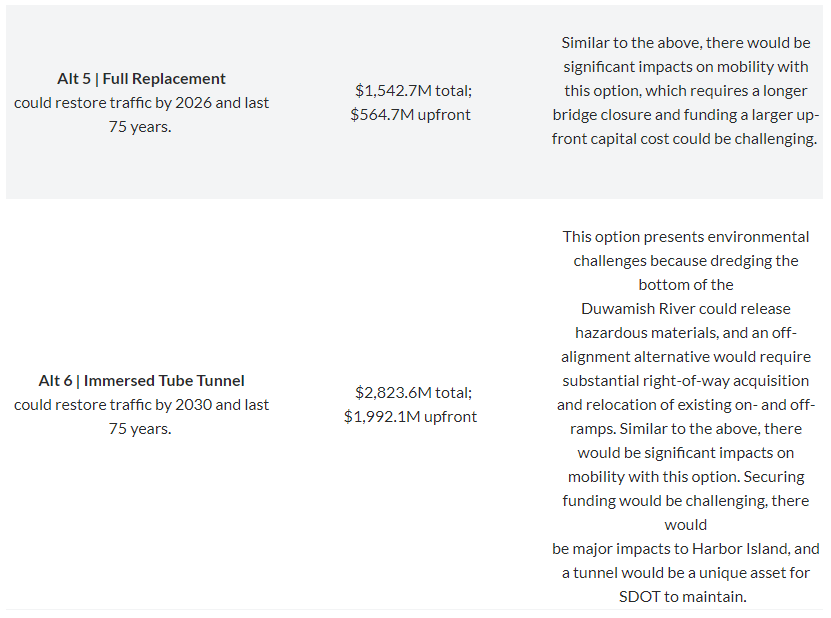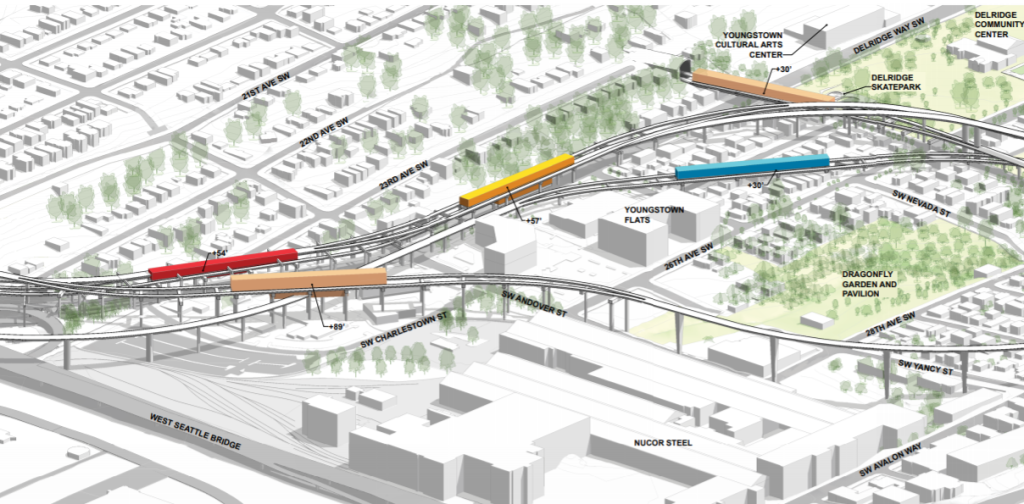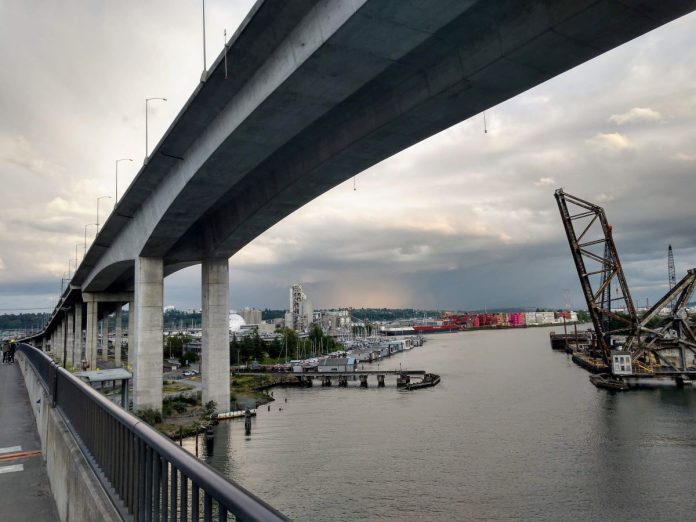The West Seattle Bridge was just 36-years-young when it cracked, sagged, and threatened to collapse, adding another layer of pollution to the already highly polluted Duwamish River. The city grappled with what to do: repair or replace. Yesterday the Seattle Department of Transportation (SDOT) released its cost-benefit analysis revealing a replacement option scored highest: “Alternative 4 (superstructure replacement) was the overall best performer.”
Normally 36-year-old bridges don’t need replacing, but these are unique circumstances. Although messaging has varied since the bridge closed for emergency shoring in March, SDOT has highlighted how expensive and uncertain repair could be. A repair bridge could last 15 years or a lot less or more. It’s hard to gauge. One the thing the agency does know is that a repaired bridge would need constant tending and expensive maintenance on a yearly basis to keep it from deteriorating once more. In fact SDOT’s consultant WSP put the price tag at approximately $916 million to quantify the lifecycle costs of repairs over 79 years.


Publications like The Seattle Times and West Seattle Blog highlighted that repair would cost “only” $47 million upfront in their headlines and coverage. But that overlooks how expensive it will be maintain the repaired bridge; the millions in annual maintenance clarify the city’s decision. Better pull off a leaky band-aid and get stitches than slowly be bled dry.
SDOT finances are it too sorry of a shape to throw good money after bad trying to put an ailing bridge on life support. Bridge maintenance costs could end up swallowing up the rest of the SDOT budget–and rarely are there grants for maintenance–which jeopardizes investment in infrastructure for people walking, rolling, biking, and riding transit.
Replacement isn’t cheap either and requires more money upfront, but it offers more certainty. WSP puts superstructure replacement at $1 billion total with $383.1 million upfront. The other replacement options–full replacement and the immersed tube tunnel are even spendier with the immersed tube requiring almost $2 billion upfront. The immersed tube is complicated by environmental factors–the Duwamish River is a superfund site and disturbing the riverbed could release more pollution.
A newly designed replacement bridge opens up the possibility for multimodal improvements, which could allow the City to make major progress on its long-term transit and climate goals. That means fewer car lanes, as we’ve already argued as a citywide bridge policy, and adding space for light rail. This could save a ton of money on Sound Transit 3 and open the door to accelerating West Seattle Link even as the recession eats into Sound Transit revenue.
SDOT has suggested it may be able to replace the bridge in just three years using an accelerated planning process and bridge span partially constructed off site. This would require bypassing the environmental impact statement (EIS) process, a privilege basically never bestowed upon biking and transit infrastructure. In this case, since there are cars to move, the City appears ready to move mountains. That’s too bad since car emissions make up the biggest chunk of Seattle’s carbon footprint by far.
We’re doubtful three years is actually doable, but replacement is still the best option. Light rail adds another layer of complexity in planning, but SDOT doesn’t need to wait for the whole light rail extension to be planned to move ahead with a light rail compatible bridge. It needs only confirm the bridge could link with the two adjoining stations and fit the alignment. The cost-benefit analysis confirmed that SDOT has already started those conversations with Sound Transit.

But what about a West Seattle light rail tunnel you ask? Well that ship has sailed unless Seattle is prepared to raise hundreds of million of additional dollars on top of a similarly large amount of money needed to fund the West Seattle Bridge replacement.
Mayor Jenny Durkan’s decision around the West Seattle Bridge had been expected this week. She has delayed that decision, but the choice is clear. Let’s build the bridge of the future instead of pouring money into the freeway of the past.
The Editorial Board consists of Natalie Bicknell, Ryan Packer, and Doug Trumm.
The Urbanist was founded in 2014 to examine and influence urban policies. We believe cities provide unique opportunities for addressing many of the most challenging social, environmental, and economic problems. We serve as a resource for promoting and disseminating ideas, creating community, increasing political participation, and improving the places we live.


